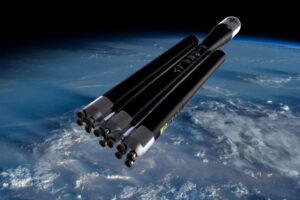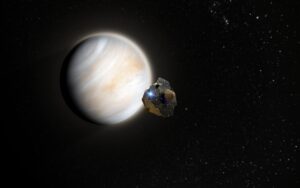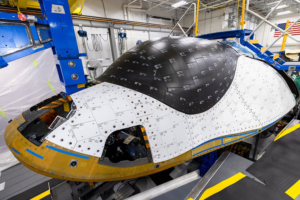
New Gateway Electric Propulsion Developments
NASA’s updated plan to return humans to the Moon involves a focus on setting up infrastructure to support these missions such as Gateway. This lunar space station will serve as a multi-purpose outpost orbiting the Moon that provides essential support for long-term human return to the lunar surface and serves as a staging point for deep space exploration.
For the past few years, we have seen consistent work on both the segments of this station and some of its primary components. Just days ago we learned more about Gateway’s electric propulsion system thrusters which are one of a kind and will help control and move the station around. Recent testing by the agency is showing very promising results on innovative technology.
Once complete, these thrusters will check off a significant milestone and make the station one step closer to its first segment launch scheduled for next year. Here I will go more in-depth into this recent development, its significance toward returning humans to the Moon, what to expect in the coming months, and more.
Electric Propulsion Update

For many years NASA has envisioned the use of electric propulsion for a variety of space based applications. Just yesterday the agency tweeted saying, “Testing… Testing… Gateway’s cutting-edge solar electric propulsion thrusters. Engineers @NASAGlenn tested the Power and Propulsion Element SEP thrusters that will change the in-space propulsion game.”
Specifically, engineers from NASA and Aerojet Rocketdyne are beginning qualification testing on the cutting-edge solar electric propulsion (SEP) thrusters that they believe will change the in-space propulsion game. The culmination of this work will see these innovative thrusters fly on Gateway beginning in 2025, making it the most powerful SEP spacecraft ever flown.
Led by NASA’s Technology Demonstration Missions program, the Advanced Electric Propulsion System (AEPS), built by Aerojet Rocketdyne, provides 12 kilowatts of propulsive power – over two times more powerful than current state-of-the-art in-space electric propulsion systems. These innovative systems tout extremely high fuel economy at lower thrust, providing mission flexibility and capabilities not achievable using traditional chemical propulsion systems. Three thrusters will be used on the Power and Propulsion Element (PPE) to maneuver Gateway during its planned minimum 15-year mission.
“AEPS is truly a next-generation technology,” said the AEPS project manager at NASA’s Glenn Research Center in Cleveland. “Current electric propulsion systems use around four and a half kilowatts of power, whereas here we’re significantly increasing power in a single thruster. That capability opens a world of opportunity for future space exploration, and AEPS will get us there farther and faster.” The thrusters must undergo qualification testing before being certified to fly on Gateway. The combined NASA-Aerojet team will use two qualification units – models nearly identical to the thrusters that will fly on PPE – during these tests.
In early July, engineers from NASA Glenn, the agency’s Jet Propulsion Laboratory, and Aerojet Rocketdyne began a yearlong series of tests at multiple locations to ensure the propulsion system operates properly and meets requirements. The engineers will first perform acceptance testing on one of these model thrusters to make sure it was built correctly, then subject it to extreme vibration, shock, and thermal conditions, similar to what it will experience during launch and flight operations. The team will also hot fire the unit before and after these tests, operating it at varying power levels to simulate flight conditions and collect performance data.
“This testing campaign is a big deal,” said one of the lead project engineers. “It’s kind of the final leg before we test the thrusters that will actually fly on Gateway.” A second qualification unit will arrive at NASA in 2024 to undergo a wear test that mimics the anticipated conditions the propulsion system will experience during Gateway’s initial orbit raising and transition to lunar orbit. NASA expects the thrusters to operate for 23,000 hours total during a nearly four-year test campaign inside NASA Glenn’s massive vacuum chambers.
To ensure Gateway is ready for launch and its transit to the Moon, the PPE’s actual flight thrusters are being built now and will launch to space before the entire multi-year wear test is complete. The program manager also commented “With NASA missions, launch dates are critical. In this case, NASA is trying to expedite the process, and we’re doing it intelligently. We will complete a few thousand hours of wear testing to prove successful operations before PPE launches. We’ll then complete the final 15,000 hours or so to fully qualify AEPS for future customers, including those at NASA and other government agencies and commercial partners.” High-power electric propulsion is critical for future crewed transportation systems that will be key in helping NASA explore more of deep space beyond the Moon, the engineers say.
Gateway Overview

Over the future lifetime of Gateway, it will start with only a few modules and continue to grow overtime. This being said, some modules are more important than others including the Power and Propulsion Element or PPE. As astronauts live and work on Gateway to enable sustained exploration and research in deep space, their efforts will be made possible by this module. A foundational component of the lunar outpost and the most powerful solar electric spacecraft ever flown, PPE will provide Gateway with power and allow it to maintain its unique orbit around the Moon.
PPE will generate 60kW of electrical power, which will power Gateway’s subsystems and its solar electric propulsion (SEP) system to keep the station in orbit around the Moon. PPE leverages technology advancements from past successful electric propulsion missions – such as the recent DART mission – to help NASA push the boundaries of what’s possible in deep space.
The greater fuel economy enables lower-cost missions that can carry more cargo. This is because the spacecraft’s propellent mass can be reduced up to 90% by being augmented with energy from the Sun. Once deployed, PPE’s two large, yoga-mat-like roll-out solar arrays – which are approximately the size of a football field’s endzone – will generate power to ionize and accelerate Xenon gas, using a tenth of the propellant required by conventional chemical propulsion systems. As the powerhouse of Gateway, the PPE will provide capabilities for high-rate communications between the station, the lunar surface, and Earth.
PPE is just one element of Gateway, but it is foundational. To form the initial Gateway space station, PPE will be integrated with Gateway’s Habitation and Logistics Outpost (HALO) module, where astronauts will live, work, and prepare for lunar surface missions. PPE and HALO will be joined together at NASA’s Kennedy Space Center in Florida, launched on a SpaceX Falcon Heavy rocket, and will spend about a year transiting through deep space before entering a unique near-rectilinear halo orbit (NRHO) around the Moon.
This orbit is where Gateway will end up and where the electric propulsion will work to keep Gateway stationed. NASA is confident that NRHO is just right for Gateway, marrying the upsides of low lunar orbit (surface access) with the benefits of distant retrograde orbit (fuel efficiency). Hanging almost like a necklace from the Moon, NRHO is a one-week orbit that is balanced between the Earth’s and Moon’s gravity. This orbit will periodically bring Gateway close enough to the lunar surface to provide simple access to the Moon’s South Pole where astronauts will test capabilities for living on other planetary bodies, including Mars. NRHO can also provide astronauts and their spacecraft with access to other landing sites around the Moon in addition to the South Pole.
The benefits of NRHO don’t end with surface access and fuel efficiency. NRHO will allow scientists to take advantage of the deep space environment for a new era of radiation experiments that will inspire a greater understanding of the potential impacts of space weather on people and instruments. NRHO will also give Gateway a continuous line of sight, or “view”, of Earth, translating to uninterrupted communication between Earth and the Moon.
The Gateway Program is building a small, human-tended space station orbiting the Moon that will provide extensive capabilities to support NASA’s Artemis campaign. Built with international and commercial partnerships, Gateway’s capabilities for supporting sustained exploration and research in deep space include docking ports for a variety of visiting spacecraft, space for crew to live and work, and on-board science investigations to study heliophysics, human health, and life sciences, among other areas. Gateway is supposed to be a critical platform for developing technology and capabilities to support Moon and Mars exploration in the coming years. Something we can expect more updates on in the near future as development continues.
Conclusion
NASA is getting close to some cutting-edge tests of Gateway’s future electric propulsion system. This technology is complex and unique but could help save both money and time by providing an extremely fuel-efficient propulsion device. We will have to wait and see how it progresses and the impact it has on the space industry.



